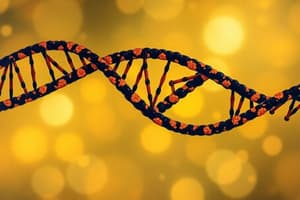Podcast
Questions and Answers
What is the primary role of RNA polymerase during transcription?
What is the primary role of RNA polymerase during transcription?
- To unwind the DNA double helix during replication
- To edit mRNA before it exits the nucleus
- To bind to promoters and synthesize mRNA (correct)
- To facilitate the translation of mRNA into proteins
How does RNA polymerase identify where to begin transcription?
How does RNA polymerase identify where to begin transcription?
- By binding to specific promoter sequences in the DNA (correct)
- By interacting with other RNA molecules present
- By recognizing intron sequences in the DNA
- By attaching to ribosomes within the nucleus
What modifications occur to the newly synthesized mRNA before it exits the nucleus?
What modifications occur to the newly synthesized mRNA before it exits the nucleus?
- Attachment of a cap and tail, and removal of introns (correct)
- Replication of mRNA strands
- Conversion of exons to introns
- Addition of introns
What distinguishes exons from introns during RNA processing?
What distinguishes exons from introns during RNA processing?
What is the function of promoters in transcription?
What is the function of promoters in transcription?
What is the primary function of messenger RNA (mRNA) in the cell?
What is the primary function of messenger RNA (mRNA) in the cell?
Which component distinguishes RNA from DNA?
Which component distinguishes RNA from DNA?
What is the role of RNA polymerase during transcription?
What is the role of RNA polymerase during transcription?
Which type of RNA is primarily responsible for transporting amino acids to the ribosome?
Which type of RNA is primarily responsible for transporting amino acids to the ribosome?
Which statement correctly describes the structure of ribosomal RNA (rRNA)?
Which statement correctly describes the structure of ribosomal RNA (rRNA)?
Flashcards are hidden until you start studying
Study Notes
Comparing RNA and DNA
- RNA contains ribose as its sugar, whereas DNA has deoxyribose.
- RNA is typically single-stranded, while DNA is double-stranded.
- In RNA, uracil replaces thymine, which is found in DNA.
Roles of DNA and RNA in Cells
- DNA holds and transfers genetic information, acting as the blueprint for organisms.
- RNA codes for amino acids and serves as a messenger between DNA and ribosomes for protein synthesis.
- RNA is essential for utilizing the genetic instructions stored in DNA.
Types of RNA
-
Messenger RNA (mRNA)
- mRNA is a copy of the DNA segment that encodes a protein.
- It is synthesized in the nucleus and transports genetic information to the cytoplasm for protein synthesis.
-
Ribosomal RNA (rRNA)
- Ribosomes, composed of rRNA and proteins, facilitate protein synthesis.
- Consist of two subunits that play a critical role in assembling amino acids into proteins.
-
Transfer RNA (tRNA)
- tRNA is responsible for transporting amino acids to the ribosome during protein synthesis.
- It interacts with mRNA to ensure the correct amino acids are added to the growing polypeptide chain.
RNA Synthesis: Transcription
- During transcription, DNA segments act as templates to synthesize complementary mRNA strands.
- RNA polymerase is the enzyme responsible for synthesizing mRNA by binding to promoter regions on DNA.
- Promoters are specific DNA sequences that signal RNA polymerase where to begin and end transcription.
RNA Editing: Introns and Exons
- Newly synthesized mRNA undergoes editing before exiting the nucleus.
- Introns are non-coding segments that are removed during the editing process.
- Exons are coding sequences that remain and are spliced together to form the final mRNA transcript.
Key Terms
- RNA Polymerase: Enzyme that synthesizes mRNA from a DNA template.
- Promoter: Specific DNA sequence where RNA polymerase binds to initiate transcription.
- Intron: Non-coding regions of RNA that are deleted during processing.
- Exon: Coding regions of RNA that are retained and expressed in the protein synthesis process.
Studying That Suits You
Use AI to generate personalized quizzes and flashcards to suit your learning preferences.




